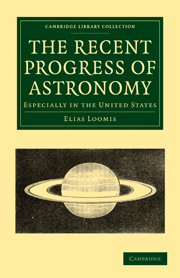Book contents
- Frontmatter
- PREFACE
- Contents
- CHAPTER I RECENT ADDITIONS TO OUR KNOWLEDGE OF THE PLANETARY SYSTEM
- SECTION I
- SECTION II
- SECTION III
- SECTION IV
- SECTION V
- CHAPTER II RECENT ADDITIONS TO OUR KNOWLEDGE OF COMETS
- CHAPTER III ADDITIONS TO OUR KNOWLEDGE OF FIXED STARS AND NEBULÆ
- CHAPTER IV PROGRESS OF ASTRONOMY IN THE UNITED STATES
- POSTSCRIPT
- Frontmatter
- PREFACE
- Contents
- CHAPTER I RECENT ADDITIONS TO OUR KNOWLEDGE OF THE PLANETARY SYSTEM
- SECTION I
- SECTION II
- SECTION III
- SECTION IV
- SECTION V
- CHAPTER II RECENT ADDITIONS TO OUR KNOWLEDGE OF COMETS
- CHAPTER III ADDITIONS TO OUR KNOWLEDGE OF FIXED STARS AND NEBULÆ
- CHAPTER IV PROGRESS OF ASTRONOMY IN THE UNITED STATES
- POSTSCRIPT
Summary
The discovery of the planet Neptune took place under circumstances most extraordinary. The existence of the planet was predicted, its path in the heavens was assigned, its mass was calculated, from considerations purely theoretical. The astronomer was told where to direct his telescope, and he would see a planet hitherto unobserved. The telescope was pointed, and there the planet was found. In the whole history of astronomy we can find few things equally wonderful. This discovery resulted from the study of the motions of the planet Uranus.
Uranus was first discovered to be a planet in 1781, but it had been repeatedly observed before by different astronomers, and mistaken for a fixed star. Nineteen observations of this description are on record, one of them dating as far back as 1690. In 1821, M. Bouvard, of Paris, published a set of tables for computing the place of this planet. The materials for the construction of these tables consisted of forty years’ regular observations at Greenwich and Paris since 1781, and the nineteen accidental observations, reaching back almost a century further. Upon comparing these observations, Bouvard found unexpected difficulties. He was unable to find any elliptic orbit, which, combined with the perturbations by Jupiter and Saturn, would represent both the ancient and the modern observations. When he attempted to unite the ancient with the modern observations, the former might be tolerably well represented, but the latter exhibited discordances too great to be ascribed to errors of observation. Not being able to explain this discrepancy in any satisfactory manner, he rejected the ancient observations, and founded his tables upon the observations since 1781.
- Type
- Chapter
- Information
- The Recent Progress of AstronomyEspecially in the United States, pp. 9 - 53Publisher: Cambridge University PressPrint publication year: 2010First published in: 1856



